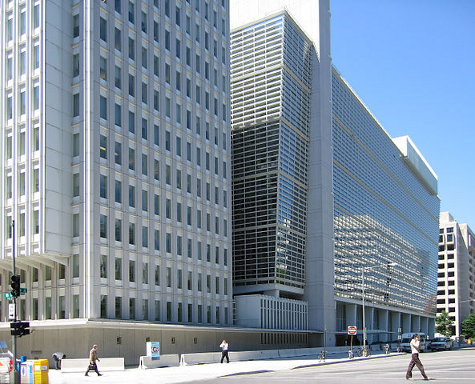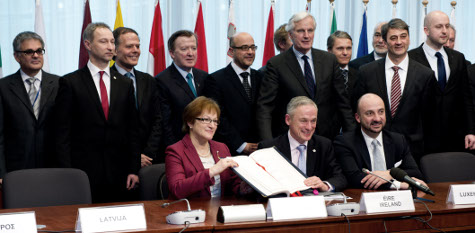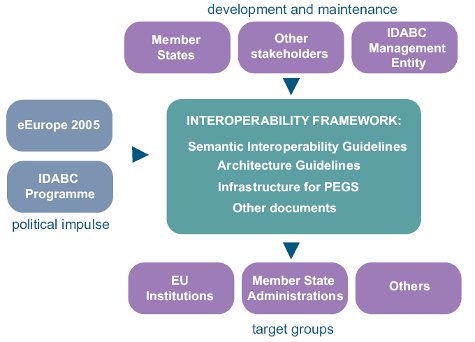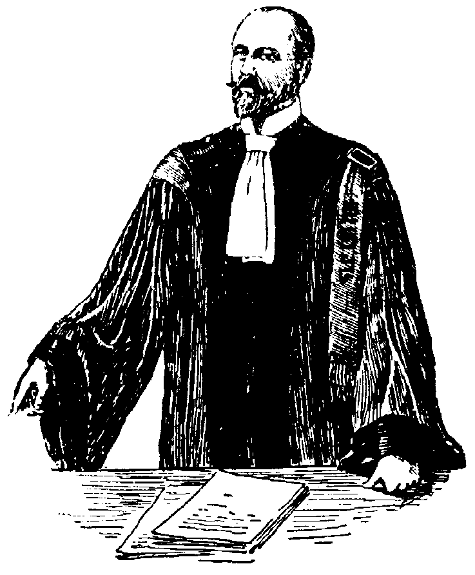A couple of minutes ago I was called in by a KSNH paralegal to assist her in filing an application for a national German trade mark application utilising the new DPMAdirektWeb facility which is available to the public since November 12, 2013. She had just arrived at a step where the items of the list of goods and services are to be entered. To her surprise there was no visible option just to enter free text. The user appeared to be forced to select from a picklist drawn from a lager database of goods and services already known to the DPMA from earlier applications. And, it turned out that the specific item the client wanted to see within the list of goods and services was not available in the picklist offered by the new website.
I couldn’t believe that the new filing system is crippled that way and immediately called a DPMA hotline number indicated on the DPMAdirektWeb page. To my surprise the lady at the other end of the line confirmed that it is not possible to enter arbitrary text into the list of goods and services.
Well, is such action of the DPMA really within the bounds of applicable law?
As far as I know neither German Trade Mark Act nor Directive 2008/95/EC of the European Parliament and of the Council of 22 October 2008 do comprise any provision allowing Offices to hinder applicants to file trade mark applications covering goods and/or services which are new to the respective internal database of acceptable items.
It is just that Offices like to streamline their internal processes by preferring to deal with pre-approved lists of goods and/or services only.
The German Patent and Trade Mark Office (DPMA) is one of many administrative agencies of the Federal Republic of Germany. Its task is to implement the law, not to create new law.
I have not yet bothered to obtain an Official statement of the DPMA concerning this matter. But I would not be very much surprised if they argue that any applicant insisting on using an individually worded list of goods and services still may refer to a paper-based way of filing the application. However, doing so comes with EUR 10,– extra costs for Official application fees. And, yes, we patent attorneys usually can switch to the DPMAdirekt on-line filing facilities which have ownership of a smartcard as a prerequisite.
But I prefer to see this as a matter of principle: If the law allows to file individually worded lists of goods and services, every filing facility should support such kind of freedom.
I can see that DPMA might strongly feel encouraged by the bad example given by OHIM to proceed on a way of nudging applicants to follow paths where the interest of the respective administrative agency to have smooth, fast and cheap internal workflows is fostered at maximum at the expense of the applicant’s interest to have a trade mark perfectly tailored to its needs. However, OHIM at least allows free text in lists of goods and services – although the current as well as the future OHIM on-line web filing TM facility (operative from December 02, 2013 onwards) both have plenty of nag-screens warning the user when departing from the path of virtue which requires to stick to the internal database of pre-approved items.
Back in 2004, Germany saw a fundamental reform of the German Act on Registered Designs (“Geschmacksmustergesetz”): Before, Gebrauchsmusterschutz was defined as sort of a small coin of Copyright (“Kleine Münze des Urheberrechtes”). In particular, the old Act on Registered Designs made use of the concept of level of originality (“Gestaltungshöhe”) which is a characteristic of German Copyright (Urheberrecht). Thereafter, the new Geschmacksmustergesetz (only recently renamed in German as Gesetz über den rechtlichen Schutz von Designs because of even many German native speakers did no longer understand what really was meant in this context with the German word “Geschmack” which normally would translate to “taste”.) was a fresh start from scratch undertaken to fulfil the requirements of the Directive 98/71/EC of the European Parliament and of the Council of 13 October 1998 on the legal protection of designs. Since this reform, German Geschmacksmusterrecht no longer was officially defined as small coin of Copyright. The the concept of level of originality disappeared from the law.
In the old times before the reform in 2004, creators of everyday’s works of so-called applied arts (“Angewandte Kunst”) were referred to the Gebrauchsmusterschutz whereas creators of purpose free arts (“Zweckfreie Kunst”) were in a position to gain protection by Copyright law more easily. In order to be eligible for Copyright protection, works of applied arts needed to show some higher level of originality than works of purpose free arts. This meant that the designs of many common household objects etc. were effectively copyright-free unless the design was registered as Geschmacksmuster. This does not mean that object designs generally were excluded from Copyright; it was just harder to obtain protection. For example, the design of the famous cantilever chair created by Mies van der Rohe et al. in all its elegance was found to be protected by Copyright in 1932 by German Reichsgericht.
But on November 13, 2013, the German Federal Supreme Court (Bundesgerichtshof, BGH) has clarified in Decision I ZR 143/12 (Press Release [in German]) that after entering into force of the reformed Geschmacksmustergesetz based on Directive 98/71/EC in 2004 there is no longer any room for a differentiation between works of applied arts, on the one hand, and works of purpose free arts, on the other hand, when it comes to the consideration of the required level of originality required for being eligible to Copyright protection.
In practice this means that, related to Germany, discussion of design infringement even in cases with common household objects etc. must no longer stop after evaluating registered Designs (formerly known as Geschmacksmuster). From now on, it is clear that Copyright should be considered also in small-coin cases.
As there is no such thing like a Copyright Register, it is hard to search for earlier rights. Theoretically, the creator of some new common household article etc. might feel safe if he or she is sure that the design in question indeed is a creation of his or her own. But in court, when being confronted with some earlier work looking confusingly similar, it might be hard to defend that the new design isn’t simply some derivative work of the old one. The field of common household articles might turn out to be quite crowded in the field of lower levels of originality.
(Foto: (C) 2010 by Tim Bartel aka avatar-1 via Flickr and, on 2013-11-14, licensed under the terms of a Attribution-ShareAlike 2.0 Generic (CC BY-SA 2.0) license.)
As everyone is aware, a new European Unified Patent Court system is in the making. The Unified Patent Court Agreement (UPCA) has been signed by all of the EU Member States but Spain and Poland and is now waiting for at least 13 ratifications (including Germany, United Kingdom, and France) in order to eventually enter into force. And, there is a fierce debate as to whether or not the effects of this new system will be beneficial.
However, there appears to be some chance that another concurrent aspect of recent developments of relevance for Intellectual Property might get overlooked.
The Transatlantic Free Trade Area (TAFTA) or Transatlantic Trade and Investment Partnership (TTIP) is a proposed free trade area between the United States and the European Union. As we can learn from Wikipedia, it was considered in the 1990s and again in 2007. In 2013, “United States-European Union High Level Working Group on Jobs and Growth” recommended the start of negotiations on the Transatlantic Trade and Investment Partnership. It represents potentially the largest regional free-trade agreement in history, covering more than 40% of world GDP, and accounting for large shares of world trade and foreign direct investment.
On 14 June, Member States gave the European Commission the green light to start trade and investment talks with the United States. Currently, the negotiations are stalled due to the U.S. Government shutdown but there is little doubt that the talks will resume as soon as Government business is re-started in Washington, D.C.
Unfortunately, the negotiations are shrouded in secrecy, and so far no meaningful conference documents appear to have been leaked. It appears, however, quite clear that TAFTA/TTIP is not negotiated to be mainly about reducing customs tariffs or the like. On the contrary, the entire project is designed as an approach to revise a huge field of national U.S. and regional EU laws with effect on trade. It might well be seen as some sort of a ‘backdoor’ to amend many established acts enshrined in the respective statute books for the sake of creating trans-atlantic level field for influential businesses.
In this very context, Zach Carter and Ryan Grim recently wrote in the Huffington Post:
[O]ne aspect of the agreement, known as “investor-state dispute resolution,” would allow a company to appeal a regulatory rule or law to an international court, most likely the World Bank. The international body would be given authority to impose economic sanctions against any country that violated its verdict, including the United States. The international body would be given authority to impose economic sanctions against any country that violated its verdict, including the United States.
A spokesperson for the Office of the United States Trade Representative confirmed to HuffPost that the agency “will seek the inclusion of procedures for expeditious, fair and transparent investor-state dispute resolution” under a new pact with the EU, but said that the new legal framework will be “subject to appropriate safeguards and the protection of legitimate government regulatory interests.”
Up to now, I do not have any insight if TAFTA/TTIP might influence Intellectual Propertly law by imposing investor-state dispute resolution procedures on Intellectual Property disputes. But there is a corresponding precedent under the NAFTA agreement:
The North American Free Trade Agreement (NAFTA) is an agreement signed by Canada, Mexico, and the United States, creating a trilateral trade bloc in North America. The agreement came into force on January 1, 1994. It also comprises clauses for investor-state dispute resolution.
In December 2012, drug giant Eli Lilly brought a NAFTA case against the Canadian government after it invalidated a patent for one of the company’s medications.
Public Citizen Inc. and/or Public Citizen Foundation reported on www.citizen.org:
In November 2012, Eli Lilly and Company initiated formal proceedings under the North American Free Trade Agreement (NAFTA) to attack Canada’s standards for granting drug patents, claiming that the invalidation of a patent violated three special investor privileges granted by the agreement. The investor privileges provisions included in NAFTA and other U.S. “free trade” agreements (FTAs) empower private firms to directly challenge government policies before foreign tribunals comprised of three private-sector attorneys, to claim that the policies undermine investors’ “expected future profits,” and to demand taxpayer compensation. Eli Lilly’s NAFTA investor-state challenge marks the first attempt by a patent-holding pharmaceutical corporation to use the extraordinary investor privileges provided by U.S. “trade” agreements as a tool to push for greater monopoly patent protections, which increase the cost of medicines for consumers and governments. Eli Lilly is demanding $100 million in compensation.
Eli Lilly launched its NAFTA attack after Canadian courts invalidated Eli Lilly’s monopoly patent rights for an attention deficit hyperactivity disorder (ADHD) drug called Strattera. The Canadian courts did so after determining that Eli Lilly had presented insufficient evidence (a single study involving 22 patients) when filing for the patent to show that Strattera would deliver the long-term benefits promised by the company. While the $100 million NAFTA investor-state compensation demand relates to revocation of the Strattera patent, Eli Lilly makes clear in its formal “Notice of Intent” to Canada that it is not only challenging the invalidation of its particular patent, but Canada’s entire legal doctrine for determining an invention’s “utility” and, thus, a patent’s validity. While pushing for an entirely different patent standard, Eli Lilly, the fifth-largest U.S. pharmaceutical corporation, is demanding $100 million from Canadian taxpayers as compensation for Canada’s enforcement of its existing patent standards.
Well, it appears as if the Elly Lilly proceedings under NAFTA rules have not been concluded yet, and no details are available with regard to the exposition of European Intellectual Propery statutes to any TAFTA/TTIP investor-state dispute resolution clauses. Hence, there is a lot of speculation. In summary, this news sound as if NAFTA may have precedence over ordinary patent law.
Could also take TAFTA/TTIP priority over ordinary EU and U.S. patent law? Perhaps even eventually forcing the EU (and, with it, EPC) to abandon the technicality requirement in the patent statues? Nobody knows for sure so far because of the negotiation documents are so sensitive that the general public may not be allowed to read them in advance.
And, of course, any disputes on the potential benefits and perils of the Unified Patent Court could well be dwarfed if TAFTA/TTIP really would render something like the World Bank into sort of an ultimate Supreme Patent Court of the U.S. and EU combined. Proper IT laws of EU and US preferably should determine IP conflict resolution procedures under TAFTA/TTIP, not vice versa. This is a proper example of a tail wagging the dog, isn’t it?
I can’t imagine that such move would be greeted in particular by SME businesses throughout the EU. Any legal certainty might be deteriorated if the World Bank could invalidate well-established national or regional law in the field of Intellectual Property by a scratch of a pen.
Be on the guard, stay tuned.
[UPDATE 2013-10-22] For more details on the Elly Lilly Case, see this article by MARC-ANDRÉ SÉGUIN on nationalmagazine.ca.
(Photo: (C) 2006 by Shiny Things via Flickr licensed under the Terms of a CC License as documented by Wikimedia)
If court proceedings took many years and a final decision was delivered only after, say, ten years of endless deliberations or so, delivering justice this late might well be perceived as delivering no justice at all. Hence, when composing present Draft of the Rules of Procedure (RoP) for the envisaged Unified Patent Court under the still-to-be-ratified Unified Patent Court Agreement (UCPA), the Members of the Drafting Committee under the guidance of the Preparatory Committee apparently thought it might be a good idea to set short time limits within the numerous stages of the Court proceedings in order to reach a decision in the first instance after one year.
But you can fall down from a horse on either side of the saddle.
When working as a European Patent Attorney before the European Patent Office you may get accustomed to terms and deadlines that usually are integer multiples of one month, e.g. four months or six months in case of responding to a normal Office Action.
For observers from outside the law firm business this might sound like an indication of slothfulness and bureaucratic procrastination. But in reality months can pass by quite rapidly if you need instructions from a client that is not sitting a few steets apart form your Office but on another continent.
Take, for example, a case where an attorney seated in Munich acts on behalf of a client C located somewhere in the United States or in Japan. Let us further assume a frequently occurring constellation where this client C has outsourced co-ordination of overseas legal matters to a local law firm L seated in San Francisco or Tokyo, respectively.
In this case, the chain of communications from EPO to the applicant then goes as follows:
EPO --> Munich Attorney --> Law Firm (San Francisco / Tokyo) --> ApplicantApplicant --> Law Firm (San Francisco / Tokyo) --> Munich Attorney --> EPO
If merely a routine Communication of the EPO is to be answered, this chain normally is traversed only once. In the first step, the Munich attorney takes the file of the application, reads the Official Communication and writes a statement explaining its meaning, in many cases providing a sketch of the options as to how to reply thereto. When received by the intermediate Law Firm, usually an attorney located there issues another comment to put the EPO Office Action and the statement of the Munich attorney into a wider context of the overall strategy of the client. Within the client’s organisation, multiple departments and/or persons may contribute to the instructions eventually to be routed back to the Munich attorney via the intermediary Law Firm. Only after this series of exchanges of messages the Munich attorney can start with drafting a proper reply to be submitted with the EPO. In this example, at least four communication steps are necessary to receive proper instructions on how to draft a response in face of the deadline.
Of course, theoretically it is possible to hold available all the time spare attorney’s capacity in Munich and at the intermediate Law Firm (in our example in San Francisco or Tokyo) at standby in order to be prepared to immediately work on incoming communications. It is clear, however, that doing so must be an expensive exercise. Hence, in order to have a balanced workload for all nodes within the communication chain, some delay needs to be accepted. In practice, terms of several months are proven to be acceptable in most cases.
When browsing the various Rules in the 15th Draft version of the Rules of Proceedings, the fact attracts attention that there are numerous deadlines buried therein counting just from 10 to 20 days. And it is to be expected that litigation cases might be much more complex and stakes therein might be much higher than in simple prosecution cases. Therefore, it can safely be assumed that the above-mentioned chain of communication in many cases needs to be traversed more than once when litigation matters before the UPC are dealt with. And again only after this series of communication steps the response to the Court can be drafted by the Munich attorney and eventually filed with the Court.
An Era Of Discontent?
In Janurary this year I was happy to report that
In a move towards greater transparency, the European Patent Office is improving the access to the documents of the Administrative Council of the European Patent Organisation. Under this new policy, all public documents of the Administrative Council will be made available after each session and published on the EPO’s website. The documents of the October 2012 session are already accessible.
Well, let as have a look what actually has been published there …
Today, on August 30, 2013, I can see there a whopping bunch of 17 (seventeen) publicly accessible AC documents dated 2013, most of them reflecting minor technicalities. Even without having any privileged insights into the inner workings of the AC I feel much on the safe side to assert that just 17 published documents are a trickle compared to the full registry of documents circulated in that body during that time period. And, even this publication of a tiny minority of CA documents has not been announced widely and is hardly to find on the website of the EPO if you don’t already know where to look.
There appears to be only one valid conclusion: The public repository of CA documents as we see it now merely is sort of a fig leaf excuse for not wanting to have much insight into the CA business for the general public.
In this context it is important to closely examine the responsibilities: It would be grossly unfair to blame EPO personnel for this misery, Surely the general policy governing the public availability / confidentiality of CA documents is defined by the CA itself, not by EPO or its President. And the CA is made up of Representatives appointed by the EPC Member States (see Article 26 EPC). And those Representatives are not only selected by their respective national Government but also instructed, briefed, and supervised by the ministry in charge with IP politics (in most cases Ministry of Justice, I’d guess).
This means that on a high ministerial level the general thinking is that it would not be good to give plenty of information out to the general public about the proceedings of the CA of the EPO.
But it goes from bad to worse.
Earlier this year the Agreement on creating a European Unified Patent Court was signed in Brussels. As it is well known, now the Agreement needs Ratification by at least 13 participating EU Member States, including the “Big Three”, namely Germany, United Kingdom, and France, to enter into force.
While the languages of the Agreement itself and its related Statues of the Unified Patent Court are technically fixed by the signatures of the representatives of the participating EU Member States and, hence, are to be considered as final, the Rules of Procedure (RoP) have been published so far only in their 15th Draft version. According to Article 41 of the Agreement, the Rules of Procedure shall lay down the details of the proceedings before the Court. The Rules of Procedure need to be be adopted by the Administrative Committee on the basis of broad consultations with stakeholders.
As the Administrative Committee of the Unified Patent Court can constitute itself only after the Agreement has effectively entered into force, currently there is no competent body to take any binding decision in that respect.
However, the participating Member States of the EU have agreed to create a Preparatory Committee (made up of Representatives of those States like it will later on happen with regard to the Administrative Committee and currently chaired by Mr. Paul van Beukering) informally anticipating the text of the Rules of Procedure. After entering into force of the Agreement (in some future) it is politically expected that after formal inauguration of the Administrative Committee the latter will more or less just rubber-stamp the proposals of the Preparatory Committee. The present Draft Rules of Procedure have been prepared by a drafting Committee of expert judges and lawyers, and has been the subject of technical consultations with professional and industry bodies. The Drafting Committee was composed as follows:
- Kevin Mooney (UK, Chairman)
- Klaus Grabinski (DE)
- Willem Hoyng (NL)
- Winfried Tilmann (DE)
- Pierre Véron (FR)
- Alice Pezard (FR)
- Christopher Floyd (UK)
We would like not to omit to remind you that from
25 June 2013 until 1 October 2013
the Draft Rules of Procedure are be open to written comments from stakeholders or other interested parties. Respondents are requested to send them to
secretariat@unified-patent-court.org.
Only contributions received through this address will be considered. According to the Roadmap as published, the Adoption of Rules Procedure in the Preparatory Committee is then planned to happen by July 2014.
In order to simplify access to and citation, quotation and hyperlinking of the available texts of the Agreement, the Statute as well as the Rules of Procedure on an Article-by-Article or Rule-by-Rule mode, respectively, KSNH has provided an informal Wiki-Style version thereof:
- Unified Patent Court Agreement (UPCA)
- UPCA Statues of the Unified Patent Court
- Preliminary set of provisions for the Rules of procedure of the Unified Patent Court
However, yet not all cross-links between the Articles and/or Rules are in place.
With Document 7265/13 dated March 08, 2013, the Irish EU Presidency has published some information concerning setting up of the Preparatory Committee in the context of the Agreement on a Unified Patent Court. A meeting of the Friends of the Presidency group (Patents; see Document CM 1560/13) was convened on February 27, 2013, with the objective of both hearing and considering delegations’ views on how this Preparatory Committee could be organised. According to the recently published Document, a clear consensus emerged from the Signatory States endorsing a non-paper circulated by The Netherlands and Sweden, including the proposal that the work be driven by the Member States, and thus outside the framework of existing institutional structures. In this latter respect, a number of Signatory States offered to put their resources – human and/or logistical – at the service of the Preparatory Committee once it begins its work. The European Commission offered its expertise, as and when requested by the Preparatory Committee.
Now, the Permanent Representatives Committee (COREPER) is invited to take note:
- of the agreed position of the Signatory States regarding the Preparatory Committee of the Agreement on a Unified Patent Court, as set out in the paper contained in the Annex to Document 7265/13 and in the cover note thereof;
- of the intention of the Presidency to convene the inaugural meeting of the Preparatory Committee on 26 March 2013 in Brussels; and
- that Council, at the appropriate level, will be kept informed of progress of the work of the Preparatory Committee when needed.
A list of four main tasks to be elaborated in groups with project teams can be identified:
- Legal framework,
- Financial aspects,
- IT & Facilities, and
- Human resources & Training.
Today, on February 19, 2013 at 1415h, the signing ceremony of the International Agreement on the establishment of the Unified Patent Court will take has taken place in the Justus Lipsius building of the Council of the European Union located in Brussels.
The event can be followed by video streaming:
http://video.consilium.europa.eu
As far as we know, 22 countries are today going to sign the Agreement (in brackets: year of accession to EU or predecessor organisations):
- Austria (1995),
- Belgium (1952),
- Cyprus (2004),
- Denmark (1973),
- Estonia (2004),
- Finland (1995),
- France (1952),
- Germany (1952),
- Greece (1981),
- Hungary (2004),
- Ireland (1973),
- Italy (1952),
- Latvia (2004),
- Lithuania (2004),
- Luxembourg (1952),
- Malta (2004),
- Netherlands (1952),
- Portugal (1986),
- Romania (2007),
- Slovakia (2004),
- Sweden (1995), and
- United Kingdom (1973)
According to Ian Wishart of Europeanvoice.com,
Bulgaria (2007),(see UPDATE below)the Czech Republic (2004), (see UPDATE below)- Poland (2004) and
Slovenia (2004)(see UPDATE below)
have indicated that they would not be in a position to sign the agreement next week because they still had technical issues to resolve. They are expected to sign at a later date.
Continue reading »
While nowadays most of the initial filings with the European Patent Office (EPO) or with the Office for Harmonisation in the Internal Market (OHIM) are made via electronic means, a lot of other communication between the respective Office and the applicants or their representatives usually still is dealt with by paper-based means. For example, the EPO sends an awful amount of registered letters every day, and the OHIM mainly uses telefax for sending out Official communications and for receiving responses thereto.
In this context it should be noted that the new Unified Patent Court will be the first major European institution in the field of IP which adopts a policy solely allowing electronic communication, effectively banning all paper-based backdoors. Article 44 of the Agreement on a Unified Patent Court stipulates:
ARTICLE 44
Electronic procedures
The Court shall make best use of electronic procedures, such as the electronic filing of submissions of the parties and stating of evidence in electronic form, as well as video conferencing, in accordance with the Rules of Procedure.
In the 14th Preliminary set of provisions for the Rules of procedure of the Unified Patent Court this matter is picked up by Rule 4, reading as follows:
Rule 4 – Lodging of documents
Written pleadings and other documents shall be lodged at the Registry in electronic form. Parties shall make use of the offcial forms available on-line.
“Written pleadings and other documents shall be lodged at the Registry in electronic form” – no exceptions allowed. At first we note that the internal competence for dealing with filings appears to lie with the Registry of the Court. As a second point, there will be “offcial forms” for each and every potential filing which must be usted and, after being filled in, filed electronically.
Moreover, throughout the full text of the Draft Rules of Procedure there are 25 mentions of “electronic address” of the Court and/or parties involved.
Neither those above-mentioned “official forms” nor the “electronic addresses” are explained in any technical detail within the Draft of the Rules of Procedure.
Closely related to these on-line issues are telephone and video conferences as indicated in Rule 105. There is no Rule defining applicable technologies for such purposes.
Continue reading »
A few days ago, the 14th Draft of the preliminary set of provisions for the Rules of procedure of the Unified Patent Court dated January 31st, 2013, has appeared on the Internet. This means that now all main components of the new EU Unitary Patent & Unified Patent Court system are either final or at least available in a quite recent draft version. The text comprises 382 Rules and covers a wide range of procedural law to be applied in cases before the new court, including:
- Application and interpretation of the Rules of Procedure,
- Procedures before the Court of First Instance,
- Evidence,
- Provisional Measures,
- Procedures before the Court of Appeal,
- General provisions,
- Fees and legal aid.
The k/s/n/h::law blog
Some of the patent attorneys of the KSNH law firm have joined their efforts to research what is going on in the various branches of IP law and practice in order to keep themselves, their clients as well as interested circles of the public up to date. This blog is intended to present results of such efforts to a wider public.
Blog Archives
- November 2013 (2)
- October 2013 (1)
- September 2013 (1)
- August 2013 (2)
- July 2013 (3)
- June 2013 (5)
- March 2013 (5)
- February 2013 (4)
- January 2013 (5)
- December 2012 (5)
- November 2012 (5)
- July 2012 (5)
- June 2012 (8)
- May 2012 (5)
- April 2012 (3)
- March 2012 (4)
- February 2012 (5)
- January 2012 (6)
- December 2011 (12)
- November 2011 (9)
- October 2011 (9)
- September 2011 (4)
- August 2011 (7)
- July 2011 (4)
- June 2011 (1)
Blog Categories
- business methods (6)
- EPC (7)
- EPO (12)
- EU law (92)
- ACTA (8)
- CJEU (4)
- Comitology (1)
- competition law (2)
- Enforcement (6)
- EU Unified Patent Court (62)
- FTA India (1)
- TFEU (2)
- Trade Marks (5)
- European Patent Law (37)
- German Patent ACt (PatG) (1)
- German patent law (5)
- Germany (6)
- Pirate Party (3)
- International Patent Law (4)
- PCT (2)
- IP politics (10)
- licenses (2)
- Litigation (5)
- Patentability (7)
- Patents (12)
- Piratenpartei (2)
- Software inventions (10)
- Uncategorized (9)
- Unitary Patent (24)
- US Patent Law (4)
Comments
- kelle on Germany: Copyright Protection More Easily Available For Works Of “Applied Arts”
- Time Limits & Deadlines in Draft UPCA RoP: Counting The Days - KSNH Law - Intangible.Me on Wiki Edition of Agreement on Unified Patent Court Agreement (UPCA)
- Time Limits & Deadlines in Draft UPCA RoP: Counting The Days | ksnh::law on Wiki Edition of Agreement on Unified Patent Court Agreement (UPCA)
- Wiki Edition of Agreement on Unified Patent Cou... on Wiki Edition of Agreement on Unified Patent Court Agreement (UPCA)
- European Commission Takes Next Step Towards Legalising Software Patents in Europe | Techrights on EU Commission publishes Proposal of amendend Brussels I Regulation for ensuring Enforcement of UPC Judgements
Blogroll
- 12:01 Tuesday
- America-Israel Patent Law
- Anticipate This!
- AwakenIP
- BlawgIT
- BLOG@IPJUR.COM
- BP/G Radio Intellectual Property Podcast
- Broken Symmetry
- Class 46
- Director's Forum: David Kappos' Public Blog
- Gray on Claims
- I/P UPDATES
- IAM Magazine Blog
- Intellectual Property Intelligence Blog
- IP Asset Maximizer Blog
- IP CloseUp
- IP Dragon
- IP Watch
- IP Watchdog
- IPBIZ
- ipeg
- IPKat
- ITC 337 Law Blog
- Just a Patent Examiner
- K's Law
- MISSION INTANGIBLE
- Patent Baristas
- Patent Circle
- Patent Docs
- Patently Rubbish
- PatentlyO
- Patents Post-Grant
- Reexamination Alert
- SPICY IP
- Tangible IP
- The 271 Patent Blog
- The Intangible Economy
- THE INVENT BLOG®
- Think IP Strategy
- Tufty the Cat
- Visae Patentes
The KSNH blogging landscape


This blog and the German-language sister blog k/s/n/h::jur link to the two popular and privately run blogs IPJur und VisaePatentes and continue their work and mission with a widened scope and under the aegis of our IP law firm.
ksnhlaw on Twitter
- No public Twitter messages.
 KSNH::JUR Feed (german)
KSNH::JUR Feed (german)- Ist Verschlüsselung passé? September 6, 2013Auf verschiedenen Feldern beruflicher Praxis ist dafür zu sorgen, dass Kommunikation vertraulich bleibt. Die trifft beispielsweise für Ärzte zu, aber auch für Anwälte, darunter auch Patentanwälte. Einer der zahlreichen Aspekte, die in diesem Zusammenhang eine Rolle spielen, ist die Technik, um die Vertraulichkeit beruflicher Kommunikation sicherzustellen. Wa […]
- EU-Einheitspatent: Demonstrativer Optimismus und Zahlenmystik allerorten – Naivität oder politische Beeinflussung? June 26, 2013Nach mehreren vergeblichen Anläufen zur Schaffung eines EU-weiten Patentsystems wurde 1973 als Kompromiss das Europäische Patentübereinkommen unterzeichnet, welches unabhängig von der seinerzeit noch EWG genannten Europäischen Union System zur zentralisierten Patenterteilung mit nachgeordnetem Einspruchsverfahren durch das Europäische Patentamt schuf. Wie wi […]
- Moderne Zeiten oder: DPMA und Patentgericht streiten über die elektronische Akte April 25, 2013Bekanntlich hat das Deutsche Patent- und Markenamt (DPMA) im Jahre 2013 mit der rein technischen Fertigstellung der Einrichtungen zur elektronischen Akteneinsicht einen wichtigen Meilenstein seines Überganges von der Papierakte zur “elektronischen Akte” erreicht. Im DPMA werden aber bereits seit dem 01. Juni 2011 Patente, Gebrauchsmuster, Topografien und erg […]
- Gutachten zu Forschung, Innovation und technologischer Leistungsfähigkeit Deutschlands 2013 March 11, 2013Unter dem Datum vom 28. Februar 2013 ist die Bundestags-Drucksache 17/12611 veröffentlicht worden Sie trägt den Titel Unterrichtung durch die Bundesregierung - Gutachten zu Forschung, Innovation und technologischer Leistungsfähigkeit Deutschlands 2013. Die Bundesregierung legt dem Deutschen Bundestag seit dem Jahr 2008 […]
- 3D-Printing: Zum Filesharing von 3D-Modelldaten February 25, 2013In meiner kleinen zuvor angekündigten Reihe über rechtliche Aspekte des 3D Printing komme ich heute auf die Frage zu sprechen, ob die Hersteller von Gerätschaften es hinnehmen müssen, wenn Ersatztreile davon – vom Brillengestell über Smartphone-Gehäuseteile bis hin zu Rastenmähermotor-Abdeckungen – gescannt und die daraus […]
- Ist Verschlüsselung passé? September 6, 2013











